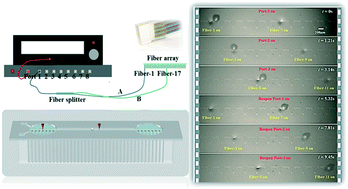An optofluidic conveyor for particle transportation based on a fiber array and photothermal convection†
Abstract
In this paper, a thermal convection-based optofluidic conveyor has been introduced, which can flexibly capture and manipulate multiple 20–120 μm silica particles with utmost accuracy. Near the end face, a fiber-based light source can confine 100 μm silica particles within 100 microns. By switching the light source of the fiber array, centimeter-range transportation of 100 μm SiO2 particles has been successfully achieved, which was not possible in optical trapping devices as we know. Through the comparative experiment with silica, polystyrene, and zirconium dioxide particles, the presented conveyor system is proved to be independent of the particles' dielectric properties. Moreover, sorting of silica and polystyrene particles based on the difference of mass densities has also been achieved. Additionally, the components of this conveyor (fiber array) and chip parts (microfluidic chamber) are freely detachable. Here, instead of expensive laser systems, a non-coherent light source has been utilized, which eventually eliminates the use of optical lens assemblies. All these features lead to making the equipment extremely simple in structure and low in cost. Besides, this optofluidic conveyor can be applied to transmit and sort various objects such as blood/cancer cells and microorganisms.



 Please wait while we load your content...
Please wait while we load your content...